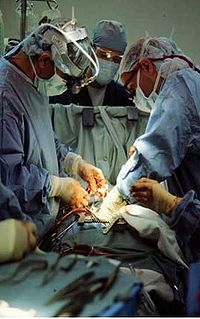
Photo from wikipedia
Since its introduction almost 40 years ago, the procedural safety of percutaneous coronary intervention (PCI) has improved enormously. In particular, the need for emergency coronary artery bypass grafting (CABG) has… Click to show full abstract
Since its introduction almost 40 years ago, the procedural safety of percutaneous coronary intervention (PCI) has improved enormously. In particular, the need for emergency coronary artery bypass grafting (CABG) has strikingly diminished, although it has not been eliminated. In consequence of this remarkable achievement, the requirement that PCI should be conducted only in centers with cardiac surgery available on-site has been gradually relaxed. In parallel with this change, primary PCI (PPCI) as immediate treatment for acute ST-elevation myocardial infarction (STEMI) has been shown to be superior therapy when it can be performed rapidly after infarction onset. These 2 forces together have led to growth in the number of centers with catheterization facilities that perform PCI without on-site cardiac surgery. Many of these centers are smaller hospitals in rural or suburban areas, and part of the justification was that they can be more rapidly and easily accessible to patients with STEMI than the more urban and distant hospitals with on-site surgical availability. Studies show that these smaller centers also are performing PCI for indications other than STEMI, that is, for urgent, nonurgent, and elective indications. For several years researchers have been examining whether PCI performed at centers without on-site cardiac surgery have worse outcomes, usually measured as mortality, compared with centers that have on-site surgery. The results so far have been uniformly negative; that is, it has never been demonstrated that clinical outcomes are any different (worse or better) at centers without on-site cardiac surgery compared with those with it. In this issue of JAMA Cardiology, Goel and colleagues1 provide additional confirmatory evidence for this lack of difference. Using data from the National Inpatient Sample (NIS) comprising almost 7 million PCI procedures, these investigators again examined the question. The PCI procedures at both types of centers were categorized by clinical indication: STEMI, non–ST-elevation acute coronary syndrome (NSTE-ACS), or elective PCI. Although unadjusted mortality rates were lower at centers with cardiac surgery on-site, after multivariate adjustment there were no differences in mortality between the 2 types for any of the 3 indications. These results echo many other reports.2-5 There are 2 findings within these new data that are worth noting. First, the investigators demonstrate quantitatively that the proportion of PCI procedures performed at hospitals without on-site cardiac surgery is increasing. Over the 10 years examined, the proportion of procedures performed at centers without on-site surgery programs increased from 1.8% in 2003 to 12.7% in 2012. Furthermore, PCI increased for all 3 clinical indications: STEMI, NSTE-ACS, and elective. These findings are similar to results from the British Cardiovascular Intervention Society database.5 The British investigators analyzed data on 384 000 patients for 2006-2012 and documented similar steady growth in the number of PCI procedures performed at centers without on-site cardiac surgery for all 3 clinical indications. They also found that there were no significant differences in clinical outcomes between the 2 types of centers after multivariate adjustment. Therefore, the observations in both countries seem to be consistent. Second, and as a direct consequence of this increasing volume of PCI procedures at centers without on-site cardiac surgery, Goel and colleagues1 have noted a potential volumeoutcome relationship: annual PCI volumes were inversely related to mortality rates at both types of centers. At centers without on-site cardiac surgery, using 200 procedures or fewer annually as reference, the adjusted odds ratio (OR) for mortality decreased to 0.87 with annual volumes of 201 to 400 procedures, and decreased to 0.84 for more than 400 procedures annually. For centers with cardiac surgery on-site, using fewer than 200 procedures annually as reference, the adjusted OR for mortality decreased to 0.95 with annual volumes of 201 to 400 procedures, and decreased to 0.84 with volumes larger than 400 procedures annually. Previously there have not been sufficient procedure volume data from centers without on-site surgery programs to investigate this question, but with increased PCI volumes at these centers it can now be examined in greater depth. The authors of this new work stress that their findings have clinical and policy implications. This is true, but first, additional studies will need to be done to either confirm or refute these volume-outcome findings for the 2 types of centers. In addition, much more investigation is needed to determine with greater precision the volume thresholds where mortality rates and other adverse event rates decline. However, an even more important consideration is that the entire reasoning for providing PCI at centers without on-site cardiac surgery will have to be reevaluated in light of these findings coupled with other ongoing developments. When it was first proposed, PCI at centers without onsite cardiac surgery was justified to provide PPCI for patients with STEMI. The expansion into non-PPCI interventions was explained as being necessary to keep the centers and staff experienced and competent, facilitate on-call coverage, and spread fixed costs over a larger number of cases. However, as regionalized systems of care for patients with STEMI (or STEMI Related article Percutaneous Coronary Intervention Without On-site Cardiac Surgery Invited Commentary
Journal Title: JAMA cardiology
Year Published: 2017
Link to full text (if available)
Share on Social Media: Sign Up to like & get
recommendations!